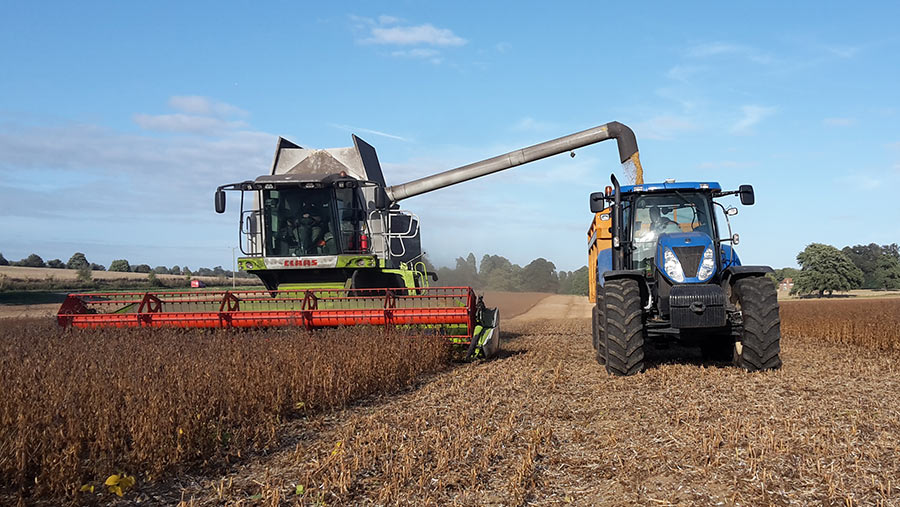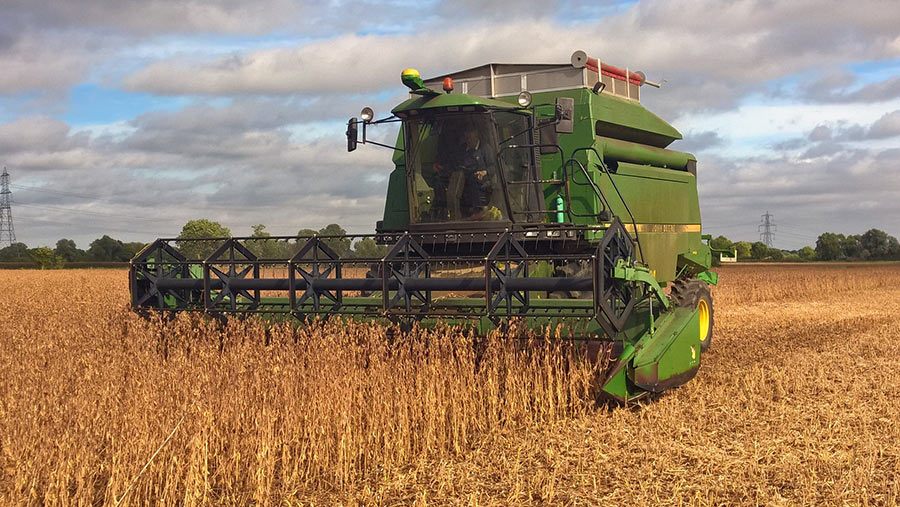Harvest 2016: Growers enjoy soya success as crop yields impress
British soya crops are are bringing a smile to growers’ faces in Kent and Cambridgeshire with early harvest results showing some impressive yields.
After a generally uninspiring cereal harvest, the scattering of soya crops in southern and eastern England have shown yields of 2.2-2.5t/ha.
This year, just over 400ha of soya was planted in the UK and currently the base market price stands at about £375/t, including a £40/t premium for non-GM beans.

Mark Izard combining his first soya crop in Kent
Kent grower Mark Izard gave the crop a go for the first time this year, planting about 34ha in the first week of May. He told Farmers Weekly that he is pleasantly surprised with the results.
See also: Winter linseed offers an alternative to beleaguered oilseed rape
So far, the crop has yielded 2.2t/ha and Mr Izard says it should have a good margin, better than beans or oilseed rape.
The crop was quite straightforward to grow and it is quick and easy to combine, despite the soya stems being pretty tough, he adds.“We started cutting the soya on Wednesday and hope to finish by the end of the week depending on the weather,” he says.
As soya is drilled in late April to early May, Mr Izard decided to grow the crop in fields with bad blackgrass infestations where he is able to get multiple flushes of the grassweed in the spring.
“We grew the variety Vilshanka and I’m happy with the crop overall. I expect to increase our acreage marginally next year to just over 100 acres [40ha],” says Mr Izard.
He also grows winter wheat, spring beans and oilseed rape, and has a beef suckler herd at Waddenhall Farm near Canterbury, Kent.
Growing soya
Advantages
- A low-input break crop
- Counts as a legume crop for greening
- Drilled from April to early May, giving ample opportunity for stale seed beds to tackle weeds
- Rotationally compatible with peas and beans
- A good nitrogen-fixer, offering 70kg/ha of nitrogen to the following crop
Disadvantages
- Not suitable to grow further north than York
- Harvesting can be late, stretching from September into October
- Grows best at altitudes of less than 600m above sea level
Mr Izard adds harvest yields have been slightly below the farm average, but quality has been good, with his biscuit wheat variety Zulu giving a good performance.
Strong performance
Meanwhile, Cambridgeshire grower Will Aldwinckle has just finished combining his third soya crop which produced a good yield of 2.5t/ha.

Will Aldwinckle cutting soya in Cambridgeshire
Mr Aldwinckle, who farms with his father Bill in Barnack near Stamford, grew about 20ha of soya this year on their 220ha farm, which also grows winter wheat, spring oats and beans.
Watch the video below of the 2015 soya harvest at the Aldwinckle’s farm.
Typical soya gross margins for 2017
| Yield (t/ha) | 2.5 |
| Market value (£/t) | 375 |
| Total income (£/ha) | 937 |
| Seed cost (£/ha) | 150 |
| Fertiliser cost (£/ha) | 60 |
| Herbicide and fungicide cost (£/ha) | 65 |
| Total input cost (£/ha) | 275 |
| Gross margin (£/ha) | 662 |
Source: Soya UK. Based on £375/t at 1 tonne per acre with full spray programme.
Soya market explained
- There is a large demand for soya, with the UK currently importing about 2m tonnes of soya meal and 1m tonnes of soya beans each year, mostly for animal feed
- The total area of soya grown in the UK this year is about 400ha
- Soya beans typically contain less oil than oilseed rape at about 20% and small feed compounders tend to use whole beans rather than extract the oil
- Global soya production is about 200m tonnes annually with about 125m tonnes traded on the world market
- The soya market is fairly tight, with China snapping up 80m tonnes and the European Union buying 30m tonnes a year. This market surplus is small and demand is rising
- With no stringent specifications to meet, the risk of having a soya crop rejected over quality is low
- UK soya prices are currently about £375/t which includes a £40/t premium for non-GM beans

